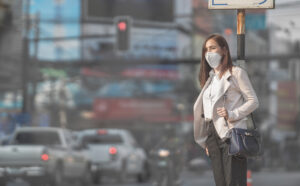What You’ll Learn About Air Quality in OBC’s HVAC Program
 Are you interested in helping others? While some may work in the medical industry to help others, you can start work as HVAC technicians. Not only do you install and fix HVAC systems, but you also improve air quality. Plus, you can learn a lot about air quality in OBC’s HVAC program.
Are you interested in helping others? While some may work in the medical industry to help others, you can start work as HVAC technicians. Not only do you install and fix HVAC systems, but you also improve air quality. Plus, you can learn a lot about air quality in OBC’s HVAC program.
What is the Current State of Our Air Quality?
Pollution levels are exceeding national air quality standards, according to the US EPA. Exposure to fine particle pollution can cause premature death and harmful effects. Increased bad ozone can cause asthma attacks, shortness of breath, and permanent lung damage.
What is the Air Quality Index (AQI)
The air quality index measures the ground-level ozone and airborne particles that pose the greatest threat. The AQI is measured from 0 to 500. The higher the value, the greater the level of air pollution and the greater the health concern. Safe levels are from 0 to 50, where air quality is satisfactory, and air pollution poses little risk. When the value reaches 101, some individuals may experience health effects. It becomes a health alert at 201, and 301 is emergency level air quality.
Who Manages Our Air Quality?
The Environmental Protection Agency (EPA) developed the Air Quality Index to offer information about the health effects of the five most common air pollutants. These pollutants include:
Ground-Level Ozone – ground-level ozone can be good or bad for health. Stratospheric ozone is good because it protects us from ultraviolet rays. Bad ozone includes things like smog. The National Ambient Air Quality Standards (NAAQS) for ground-level ozone pollution specify a maximum allowed ozone in outdoor air.
Particle Pollution– a general term for a mixture of solid and liquid droplets suspended in the air. This can include many components like sulfuric acid, ammonium sulfate and nitrate, sodium chloride, organic chemicals, soot, metals, soil or dust particles, and biological materials like pollen. The air we breathe both indoors and outdoors contains particle pollution.
Carbon Monoxide – a colorless, odorless, and tasteless substance resulting from carbon in combustion. Carbon monoxide comes from unvented gas space heaters, leaking furnaces, gasoline-powered generators, gas stoves, tobacco smoke, and worn-out combustion devices.
Sulfur Dioxide– the largest source of sulfur dioxide is from fossil fuels, industrial processes, natural sources like volcanoes, and vehicles that burn fuel.
Nitrogen Dioxide – chemicals in the atmosphere that form acid rain create a hazy or difficult-to-see effect and contribute to nutrient pollution in coastal waters.
What is the Clean Air Act?
The Clean Air Act is a comprehensive federal law that regulates air emissions from stationary and mobile sources. The law allows the EPA to establish NAAQS to ensure adequate health and environmental protection.
What about the State of Household Air Pollution?
The World Health Organization (WHO) reports on household air pollution with some facts that include:
- 2.3 billion people worldwide cook using open fires or inefficient stoves.
- 3.2 million people died as a result of poor air quality in 2020.
- Household air pollution can lead to:
- Stroke – reduced or blocked blood flow to the brain
- Ischemic Heart Disease – reduced blood flow to the heart
- Chronic Obstructive Pulmonary Disease (COPD) – long-term exposure to irritants that damage the lungs
- Lung Cancer – tobacco both primary and secondary smoke are the leading cause of lung cancer.
What Do HVAC Technicians Do to Improve Air Quality?
The Environmental Protection Agency (EPA) manages the outdoor air quality, but who manages your indoor air quality? The HVAC technician, of course. The HVAC technician is responsible for the following:
- Inspecting heating, cooling, and ventilation systems and reporting problems to customers
- Making recommendations to customers to repair or replace their unit
- Cleaning Ducts and Check for Obstructions
- Installing, maintaining, and repairing HVAC units
- Install wiring and electrical components of HVAC units
- Replacing or repairing non-working parts
- Keeping detailed written records of all work performed
HVAC Technicians help customers monitor household air quality to mitigate carbon monoxide, pollution particles, and passive smoke. This includes managing ventilation systems that improve air quality within the home. Some of the air pollutants in the home include mold, dust mites, pollen, and allergens. To enhance the quality of air, an HVAC technician can:
Increase Air Circulation – increasing air circulation helps remove dust, humidity, and uneven temperature. The HVAC technician will ensure the blower motor works on the air conditioning.
Replace HVAC Filters – a dirty filter can reduce airflow and stop filtering out harmful particles. The HVAC technician removes dust and allergens from the home by replacing HVAC filters. An HVAC filter can catch bacteria, pet dander, pollen, mold, and soot.
Regular Maintenance – ensuring the HVAC systems are working safely and effectively is an essential step in improving indoor air quality.
Recommend Indoor Air Quality Products – a customer can use a humidifier, dehumidifier, or air purifier to improve indoor air quality.
Want to Learn More?
Now that you know more about air quality, it is time to learn more about Ohio Business College. If you have a passion for heating and cooling, working in the HVAC/R industry might just be for you. Entering a career in a field as potentially rewarding as HVAC/R all starts with an HVAC/R training program. At Ohio Business College, we can help you gain the skills and knowledge that can serve as the foundation of a rewarding career as an HVAC/R technician.
Contact us today to learn more about our HVAC program.

